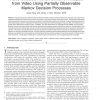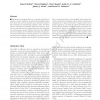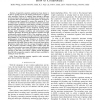9329 search results - page 1863 / 1866 » Feature interaction networks |
NECO
2007
13 years 9 months ago
2007
Learning agents, whether natural or artificial, must update their internal parameters in order to improve their behavior over time. In reinforcement learning, this plasticity is ...
PAMI
2007
13 years 9 months ago
2007
—This paper presents a method for learning decision theoretic models of human behaviors from video data. Our system learns relationships between the movements of a person, the co...
BIRTHDAY
2010
Springer
13 years 8 months ago
2010
Springer
m, modules, types and operations), different kinds of abstractions (functional/data, types/objects etc.) without falling into a loose collection of diagram languages. Considering a...
JOCN
2010
13 years 8 months ago
2010
■ Distraction and reappraisal are two commonly used forms of cognitive emotion regulation. Functional neuroimaging studies have shown that each one depends upon interactions bet...
TCOM
2010
13 years 8 months ago
2010
—Cooperative spectrum sensing has been shown to be able to greatly improve the sensing performance in cognitive radio networks. However, if cognitive users belong to different se...




